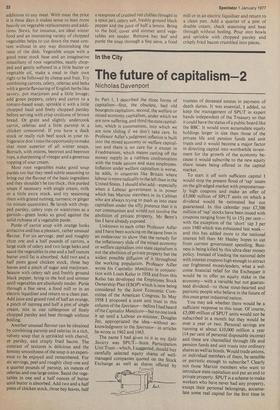Kitchen cooking in winter
Marika Hanbury Tenison
In 1976 everyone who knew their onions was growing them too, rotavating their lawn to make a cabbage patch, turning over the herbaceous border to rhubarb, globe artichokes and beets, planning next year to grow runner beans up the wire or the tennis court or replace the passion flower creeper with a fan-trained quince or fruit-bearing, jam-potential, japonica. Last summer tomatoes sprouted in every respectable backyard, strawberries on every patio, herbs flourished in window boxes and suburban gardens became a haven for aphids and ladybirds.
Growing your own vegetable produce takes time, patience and practice and if you calculate your worth per hour, tot up how many weekends you have courted fibrositis forking over the garden, your vegetables, in hard cash value, inevitably work out more expensive than if you bought them from a greengrocer. Set against this the good that the exercise is doing for your cholesterol level, work out what you save by not frittering away your Saturday and Sunday mornings, and by the satisfaction of having your own fresh produce available as and when you want it, and the odds must be loaded in favour of 'growing your own.' It's not just the satisfaction of having raised this turnip or that onion from seed that makes it all worth while, it's also the reward of having access to an instant larder containing goods in prime condition.
When we joined the Common Market I rather naively expected sellers of fresh produce in this country to perk up a bit and looked forward to reaping some of those luxuries housewives on the other side of the Channel enjoy as a fact of life. Go into almost any greengrocer in France, Belgium or Italy and you will find vegetables in tip-top condition brought into the shops daily, washed and neatly trimmed, pleasantly displayed for you to examine and pick the bunch, size or quality you want. Inexpensive bundles of root vegetables and herbs can be bought for the soup or stock pot and all year round there is an exciting choice of seasonal salad ingredients with lettuce being sold by weight rather than by a single price regardless of size or quality. No Continental greengrocer would dream of snapping, `If you don't want the goods don't muck 'em about,' and as soon as produce begins to deteriorate it is removed from sight.
In England we still, it seems, have a lot to learn from our co-Marketeers. Recently I leant over a large counter in the vegetable section of a large London store, shortsightedly pointing to a bunch of radishes and a cucumber on a shelf behind the assistant. The radishes were put into a bag without my having a chance to investigate them and it was only when I got home I discovered the leaves were slimy and decayed and the roots soft and flabby; the cucumber, sealed inside a plastic skin, was limp: 60p went into the waste bin. In almost every greengrocer's rude notices tell you not to touch, not to finger, not to squeeze, yet how on earth are you supposed to test for quality if you don't do just those things? Last year I gave up the battle, doubled our vegetable plot and determined to live as far as possible from our own fresh garden produce. Despite the drought we now reap the benefits and although my parsnips may not be entirely uniform in shape and my carrots a little on the knobbly side, at least I can squeeze them as much as I like, This is the season of root vegetables: carrots, parsnips, beetroot, turnips, salsify, scorzonera (similar to salsify but with a slightly more defined flavour), leeks, onions, celery, celeriac and swede. All the goodness of the soil, packed with vitamins, full of flavour and, if properly cooked, satisfying
additions to any meal. With meat the price it is these days it makes sense to lean more heavily on vegetable replacements and additions. Stews, for instance, are ideal winter food and an interesting variety of chopped vegetables helps to cut down the meat content without in any way diminishing the taste of the dish. Vegetable soups with a good meat stock base and an imaginative miscellany of root vegetables, neatly chopped and gently softened in a little butter or vegetable oil, make a meal in their own right to be followed by cheese and fruit. Try combining carrots, celery, celeriac and leeks with a gentle flavouring of English herbs like savory, pot marjoram and a little lovage; add green peppers, celery and carrot to a tomato-based soup, sprinkle it with a little chopped basil and finely chopped parsley before serving with crisp croatons of brown bread. Or grate and slightly undercook carrot, celeriac and a little parsnip in a chicken consommé. If you have a duck stock or really rich beef stock in your refrigerator don't miss the opportunity to make that most superior of all winter soups, Bortsch, with onions, beetroot and beetroot tops, a sharpening of vinegar and a generous topping of sour cream.
Most root vegetables make good soup purees too but they need subtle seasoning to bring out the flavour of the basic ingredient and they shouldn't be too thick; thin puréed soups if necessary with single cream, milk or a little extra stock, and try seasoning them with grated nutmeg, turmeric or ginger (in minute quantities). Be lavish with chopped parsley, celery tops or watercress as a garnish—green looks so good against the solid richness of a vegetable purée.
Purée of carrot soup with orange looks attractive and has a pleasant, rather unusual flavour. For six servings: peel and roughly chop one and a half pounds of carrots, a large stalk of celery and two large leeks and sauté the vegetables in one and a half ounces butter until fat is absorbed. Add two and a half pints good chicken stock, three bay leaves and a pinch of sugar and marjoram. Season with celery salt and freshly ground black pepper, bring to the boil and simmer until vegetables are absolutely tender. Purée through a fine sieve, a food mill or in an electric liquidiser and return to a clean pan. Add juice and grated rind of half an orange, a pinch of nutmeg and half a pint of single cream, mix in one tablespoon of finely chopped parsley and heat through without boiling.
Another unusual flavour can be obtained by combining parsnip and celeriac in a rich, velvety soup that is sprinkled with chervil, or parsley, and crisply fried bacon. The contrast of textures is delicious and the lemony smoothness of the soup is an experience to be enjoyed and remembered. For six servings, peel and roughly chop one and a quarter pounds of parsnip, six ounces of celeriac and one large onion. Sauté the vegetables in one and a half ounces of butter until butter is absorbed. Add two and a half pints of chicken stock, three bay leaves, half a teaspoon of crushed red chillies (bought in a spice jar), celery salt, freshly ground black pepper and the juice of half a lemon. Bring to the boil, cover and simmer until vegetables are tender. Remove bay leaf and purée the soup through a fine sieve, a food mill or in an electric liquidiser and return to a clean pan. Add a quarter of a pint of double cream, check seasoning and heat through without boiling. Pour into bowls and sprinkle with chopped parsley and crisply fried bacon crumbled into pieces.























































 Previous page
Previous page